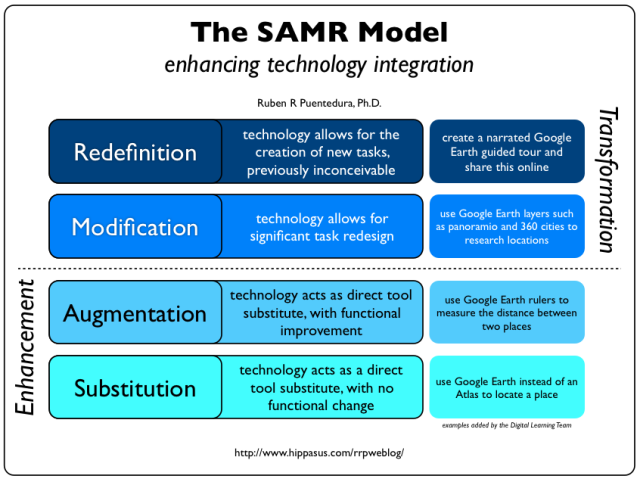SAMR in Action...My Thoughts
Previously, I posted about using the SAMR model, developed by Dr. Ruben R. Puentedura, founder of Hippasus, to work on purpose with technology use in the classroom. As I began reflecting, reading posts of others on the topic, as well as talking with practicing teachers in my district about the SAMR model, I realized that there needed to be more discussion around the practical use of the model. Below, I created a stream-of-consciousness line of thinking to show my thoughts.
Once I started to really think about the SAMR model and how I would use it to develop professional development, I also started to think about how I could help teachers in my district realistically use the model to guide their own preparation and teaching. I came up with this thought pattern, which mimics some of the examples given by Dr. Puentedura in this slideshow. I am also drawing some ideas from an article in Education Week's Teacher Leader Network (TLN) by Jennie Magiera and a blog post by Beth Holland, which I've referenced in many discussions about SAMR.
Planning thought process:
Once I started to really think about the SAMR model and how I would use it to develop professional development, I also started to think about how I could help teachers in my district realistically use the model to guide their own preparation and teaching. I came up with this thought pattern, which mimics some of the examples given by Dr. Puentedura in this slideshow. I am also drawing some ideas from an article in Education Week's Teacher Leader Network (TLN) by Jennie Magiera and a blog post by Beth Holland, which I've referenced in many discussions about SAMR.
Planning thought process:
- Objective: I always begin with the objective and assignment(s) that I would have students work on: For this example, I am going to use an idea from when I taught high school English; the most ubiquitous assignment that students would complete. The essay. I start thinking about the end goal of that assignment. Being a subscriber to the UBD (Understanding By Design) method of lesson design, I always begin with the end in mind. Therefore, I'm always thinking about where I want my students to be at the end of a lesson or unit as I am creating it to make sure that everything I have students do is guiding them to meet the objectives and levels of mastery that I expect.
- Access: Then I begin to think about the technology that I have available and I start thinking about how that technology fits into the lesson activities. For this example, the easiest way to fit technology into essay writing is to have students type their papers instead of hand-write them. This gets me to the Substitution level of the SAMR model. I could stop there, but my goal is to take this assignment and redefine it so that the technology is really being utilized to its full capacity and I'm transforming my own expectations of students to create artifacts of their learning that are authentic and meaningful.
- Adjust or Modify: Now, I begin to think about how I can adjust or modify the assignment(s) so that they leverage the power of the technologies that I have available to enhance and extend what students are able to accomplish. Here I might add in a collaborative component. I might have students begin writing their essays in a Google Drive document and share it with me and another classmate who can both read their draft, as it is in progress, and provide ongoing feedback.
- Rinse and Repeat: This pattern repeats itself until I've redesigned the assignment to publish the written works in order to extend to wider audiences, more public forums for written expression, and maybe even having intellectual conversations with experts in the fields that we are writing about (reaching out to authors, university professors, professionals in different fields of study, etc.). This redefinition of writing can go so far as this example from a teacher in Chicago who had students collaborate and crowd-source a novel that is now for sale on Amazon.com.
For more information and presentations about the SAMR model, please visit http://hippasus.com/rrpweblog and for Dr. Puentedura's podcasts, visit http://tinyurl.com/aswemayteach.
Reference:
Puentedura, R.R. (2012). About Hippasus. Retrieved from http://hippasus.com/about.html
Reference:
Puentedura, R.R. (2012). About Hippasus. Retrieved from http://hippasus.com/about.html




Comments
Post a Comment